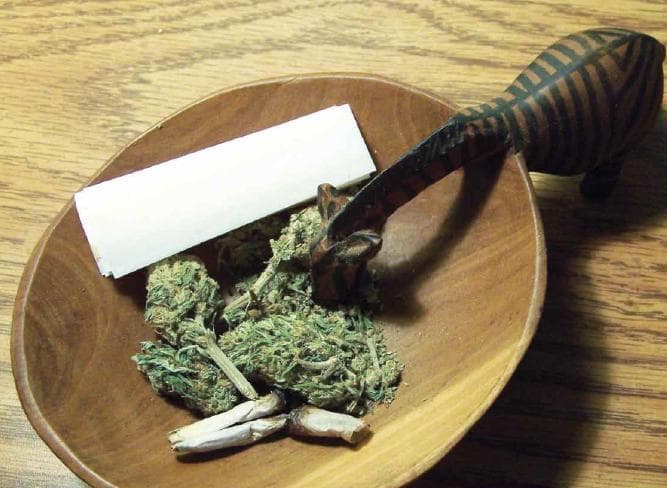Marijuana is the most commonly used illegal drug in the world with an estimated 125 million people consuming it in some form or the other every year. In India, marijuana use has been historically bound to faith and mysticism. Why then is it so stringently banned? And more importantly, should it be? Madhura Sansare embarks on a journey through the fields of hemp to find out.
Considering we are talking about such a historically controversial subject, it’s only fitting we start right at the beginning of the controversy. After all, they do say it is the best place to start a story, right? So, what was the deal with marijuana?
In the times of lore in India, marijuana was considered to be a very inculcated part of our culture. In fact, take a trip to the innermost villages in the country, and it is not uncommon to find a group of grandmothers, sitting in a squatted circle, huffing a primitive, definitely well-seasoned chillum to glory after a hearty meal. So in a country where we chose to restrict everything that a woman should or should not do since the earliest times, if marijuana was not an issue for grandmothers, who can be arguably called the pariahs of Indian virtues and culture, why do we fear the weed enough to have banned it for decades?
The history of the ban
The story started in 1961, with the ‘single convention on narcotic drugs’ the first ever international treaty to have clubbed cannabis (or marijuana) with hard drugs and imposed a blanket ban on their production and supply except for medicinal and research purposes. During the negotiations for the UN treaty signed in New York, a group of cannabis and opium producing countries, led by India, opposed its intolerance to the socio-cultural use of organic drugs. They were however overwhelmed by the US and other western countries which espoused tight controls on the production of organic raw material and on illicit trafficking. While most of the states in the US had banned all narcotic drugs by the ’40s, India had a more pragmatic approach since its colonial days: its restrictions were focused on harder substances like opium. Considering the social aspect of the drug in India, and the traditional consumption associated with it. the UN gave India 25 years to abolish the practice of use of recreational drugs. It was only towards the end of this period that the Indian government at that time, more popularly known as the Rajiv Gandhi government conformed to the 1961 treaty, the narcotic drugs and psychotropic substances act (NDPS) and thus, marijuana was illegal in India. NDPS specified that cannabis meant charas (the resin extracted from the plant), ganja (the flowering or fruiting tops of the plant) and any mixture or drink prepared from either of the two permitted forms of marijuana. Thus, NDPS allows people to smoke pot or drink bhang so long as they can prove that they had consumed only the leaves and seeds of the cannabis plant. Which, if you ask us, makes no sense at all. And of course, as with all laws, this one too stuck long enough for the practise of the law to not be associated with the terminology of it. So if you’re caught with only the leaves and the seeds of the drug today, dont expect to be spared.
Pros
Marijuana use is not as harmful as it is made out to be. In fact tetrahydrocannabinol or THC contained in marijuana has been shown to have significant health benefits. CNN’s Chief Medical Correspondent, Sanjay Gupta, wrote in an article titled Why I Changed My Mind on Weed: “Medical marijuana is not new, and the medical community has been writing about it for a long time. There were in fact hundreds of journal articles, mostly documenting the benefits. Most of those papers, however, were written between the years 1840 and 1930. The papers described the use of medical marijuana to treat ‘neuralgia, convulsive disorders, emaciation,’ among other things.”
Medical marijuana helps as a sleep aid; helps combat nausea due to chemotherapy; and helps with muscle tension, spasms and chronic pain. Further, marijuana is shown to be much less addictive than cigarettes or tobacco. Marijuana is reportedly less addictive than alochol and cigarettes. If alcohol and tobacco are legal, then why shouldn’t marijuana be legal, given that it is less lethal as well? Indeed, there have been no deaths reported of marijuana overdose. It reportedly takes 15,00 pounds of marijuana injested in 15minutes to induce a lethal response.
For all these reasons legalization of marijuana at a minimum can reduce illegal cross border trafficking, reduce illicit pot farms and create a more effective and regulated market for meeting the obvious demand for this drug, while also creating an entirely new industry that can produce marijuana not only for smoking, but hemp can also be used for textile purposes, among others. Imagine the number of jobs that can come out of this!
Cons
In support of legalization, the libertarian view is that individuals should be allowed to put whatever they want in their bodies and the liberal view is that the war on drugs has failed and that it has disproportionately impacted minorities. Either is not a sufficient argument to legalize a substance for recreational use that seriously impairs one’s judgment and health.
Its a simple judgement call. And one that needs you to look back into history. Marijuana was a part of the Indian culture for centuries, which kept its use to a minimum. Since it’s illegal status, the number of marijuana users has grown exponentially. We created a war against drugs where there wasn’t one. The country that enforced this law upon us is now slowly changing it’s own stance on the issue state-wise. The question to answer is, do we continue on with an archaic law, that wasnt even ours in the first place, or do we move on?
Volume 5 Issue 6



































